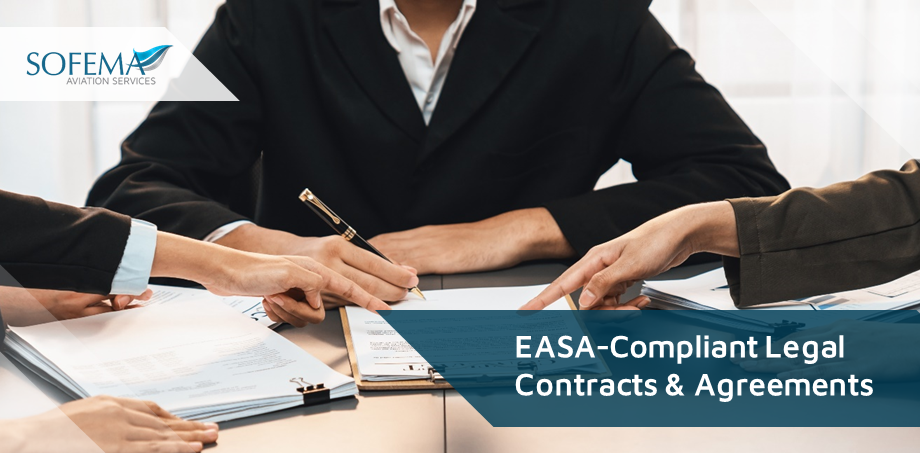Sofema Aviation Services (SAS) considers the roles and responsibilities related to the EASA-Compliant Contracts & Subcontracts.
EASA (European Union Aviation Safety Agency) compliant aviation contracts & subcontracts are essential for ensuring safety, compliance, and operational efficiency within the European aviation sector. These contracts, whether they are main contracts or subcontracts, must adhere to EASA regulations and standards. Understanding when to use a contract versus a subcontract, as well as the regulatory obligations associated with each, is crucial for aviation businesses operating within or in partnership with entities in EASA member states.
Note in terms of Certification Approval
- Contract Transfers Certification Responsibility (example 145 provides CRS Maintenance Release)
- Subcontract – Ultimate Airworthiness Authority remains with the Primary (Contracting) Organisation (for example Ground Catering Service Provider) – Responsibility remains with the Operator.
When to Use a Contract
- Direct Engagement: A contract is typically used when an aviation company directly engages another party to provide goods, services, or perform works, which can be certified by the contracting organisation. This could include procurement of aircraft parts, avionics, maintenance services, or the development of specific aviation-related software solutions.
- Primary Agreements: Contracts serve as the primary legal agreement between the service provider and the service recipient, outlining the scope of work, deliverables, timelines, payment terms, and compliance requirements with relevant EASA Certification & Full Compliance with EASA Regulations.
- Regulatory Compliance: Contracts are essential for defining the responsibilities related to EASA Certification & Compliance, including safety standards, quality assurance, and documentation requirements. They establish clear accountability for meeting regulatory obligations.
Note The Contracted Organisation is typically responsible for Certification Quality & Safety.
When to Use a Subcontract
- Work Arrangements: Subcontracts are used when a primary contractor needs to outsource part of the work to another provider (who cannot certify the work)
>> This is common in complex projects where specialized skills or resources are required that the primary contractor does not possess in-house (however the Primary Contractor Shall retain the Certification Capability)
- Supplementary Services: When additional expertise or services are needed that were not anticipated in the original contract, a subcontract can be arranged, may also include the provision of manpower.
>> This allows the primary contractor to remain compliant with the main contract while ensuring that all project aspects meet EASA standards.
- Flexibility and Scalability: Subcontracts offer the flexibility to scale operations up or down based on project needs without renegotiating the main contract.
>> This can be crucial for timely compliance with EASA regulatory or operational demands.
- Regulatory Obligations Both contracts and subcontracts under EASA oversight must address specific regulatory obligations including certification, quality & safety.
- Safety and Quality Standards Compliance with EASA safety and quality standards is mandatory.
>> Contracts must specify the standards to be met and the methods for ensuring compliance, including oversight, audits, inspections, and reporting requirements.
- Certification Requirements: For parts, components, or services that require EASA certification, the contract must detail the certification process and responsibilities.
>> This includes ensuring that all subcontracted services or products also comply with EASA certifications – Note also the comment re Subcontract Oversight & Certification
- Documentation and Record-Keeping: EASA regulations require thorough documentation and record-keeping for all aspects of aviation operations. Contracts should outline the documentation to be provided, how records will be maintained, and the duration for which they must be kept. Technical Records Should Comply with EASA Part M Subpart C or EASA Part 145.A.55
- Liability and Indemnification: Addressing liability in the case of non-compliance, accidents, or incidents is crucial.
>> Contracts must clearly define the liabilities of each party and include indemnification clauses to manage risks associated with regulatory non-compliance.
Note The Contracting Organisation is typically responsible for Certification Quality & Safety.
Next Steps
Follow this link to our Library to find & Download related documents for Free.
Sofema Aviation Services is pleased to offer the following 2 Day course – Developing and Managing Aviation Contracts in the Operations and Maintenance Environment.
Please see the following link or email team@sassofia.com with questions or comments
Tags:
Agreements, Aviation Operations, Certification Responsibility, Contract & Subcontracts Considerations, EASA compliant, EASA Regulatory Environment, EASA standards, European aviation sector., Legal Contracts, operational efficiency, Quality standards, Record-keeping, Regulatory Obligations, SAS blogs, subcontracts




